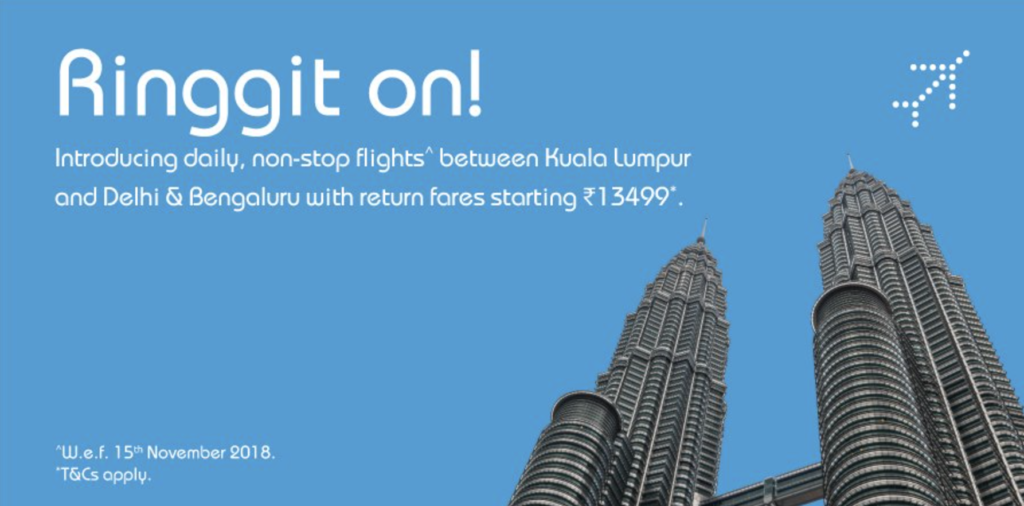IndiGo is adding routes and aircraft at a mind-boggling rate, in times of high fuel prices and diminishing profits. They have added 14 Airbus A320, 16 Airbus A320neo and 9 ATR 72-600 aircraft since January 1, 2018. This has helped them expand into Middle-East and Tier 2/3 cities domestically. They plan on ramping up their present fleet of 186 aircraft to 200 aircraft by the end of the year, making them the first airline in India to have such a large fleet. They are announcing new routes almost every week.
IndiGo is now taking the game to AirAsia’s home. IndiGo will connect Kuala Lumpur to New Delhi and Bengaluru with daily flights from November 15, 2018. They will use an Airbus A320 aircraft. As usual, they will rotate the aircraft as they do on their international routes to achieve maximum aircraft utilisation.
The schedule is
6E1821 DEL 02:55 – 10:40 KUL D
6E1822 KUL 22:05 – 00:55 DEL x2
6E1813 BLR 14:35 – 21:10 KUL D
6E1814 KUL 11:40 – 13:20 BLR D
There isn’t a flight on Tuesday night (technically) from Kuala Lumpur to New Delhi as there are two flights on Wednesday with the following schedule
6E1823 KUL 00:40 – 03:30 DEL 3
6E1822 KUL 22:05 – 00:55 DEL 3
You can fly from Bengaluru to Kuala Lumpur roundtrip for INR 13,499. You can book on Akbar Travels for instance.
Or from New Delhi for INR 15,999. You can book on Akbar Travels for instance.
 IndiGo will face stiff competition from AirAsia, Malindo Air and Malaysia Airlines. New Delhi is already connected with 25 weekly flights and Bengaluru by 18 weekly flights. Malaysia Airlines is an FSC but at times the fares are comparable to that of LCCs. AirAsia operates 4x weekly flights to Kuala Lumpur with New Delhi service on an Airbus A330 and 4x Bengaluru flights with an Airbus A320 aircraft. The majority of passengers use Kuala Lumpur as a transit. These airlines have an extensive Asia-Pacific network which passengers access through Kuala Lumpur. IndiGo will have O&D traffic but will it be enough to support daily operations?
IndiGo will face stiff competition from AirAsia, Malindo Air and Malaysia Airlines. New Delhi is already connected with 25 weekly flights and Bengaluru by 18 weekly flights. Malaysia Airlines is an FSC but at times the fares are comparable to that of LCCs. AirAsia operates 4x weekly flights to Kuala Lumpur with New Delhi service on an Airbus A330 and 4x Bengaluru flights with an Airbus A320 aircraft. The majority of passengers use Kuala Lumpur as a transit. These airlines have an extensive Asia-Pacific network which passengers access through Kuala Lumpur. IndiGo will have O&D traffic but will it be enough to support daily operations?
So what is IndiGo trying to do? IndiGo might be trying to use up available bilateral seat allocations on this route to dampen international expansion of AirAsia India on this route when they are ready to go international. It might be doing the same on other routes for the new entrants in Indian Aviation.
Bottomline
It is good to see IndiGo help increase the share of Indian airlines in International traffic to/from India. Earlier it was Air India in the long haul now it is IndiGo in the short-haul international expansion. Let’s see if IndiGo can succeed on this route because they failed when they added DEL-SIN sector due to stiff competition.
What are your thoughts on Indigo’s expansion to Kuala Lumpur?




Try launching Hyderabad – Singapore flight…